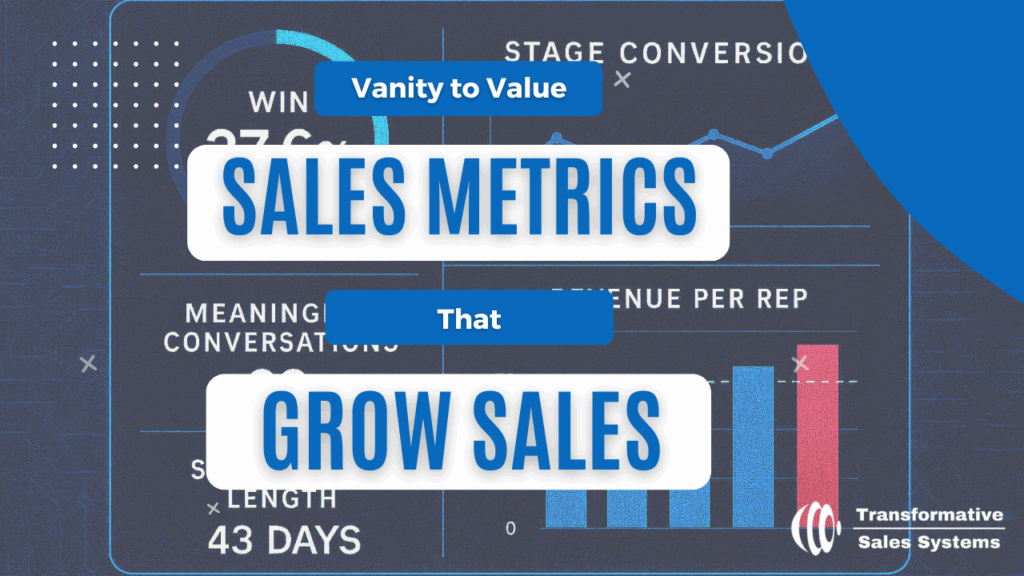You have the sales dashboard pulled up. Charts everywhere. Some lines are up and to the right. Others are flat. Your gut says something is off, but the numbers look impressive at a glance. So why are you still missing revenue goals? (HBR – The Danger of Vanity Metrics)
Here is the truth: not all sales metrics are created equal. Some look good but tell you nothing. Others rarely get the spotlight, yet they are the real drivers of growth. If you lead a small or mid-sized business and you want clarity instead of noise, this will help you focus on what actually matters.
The Dangerous Allure of Vanity Metrics
Let’s start with what does not matter as much as people think when viewed in isolation:
- Number of calls made
- Emails sent
- Meetings booked
- Proposal count
- General CRM activity
These can be helpful if they connect to outcomes. Measured alone, they create false confidence. Example: a team logs 400 cold calls in a week and celebrates. Then you learn those calls produced only three real follow up conversations. That is motion, not progress.
The Metrics That Actually Drive Growth
1) Meaningful Conversations
Track real two way conversations with decision makers. Define what “meaningful” means in your process. For example: pain discussed, budget addressed, timing confirmed, and a clear next step scheduled. If a rep had 10 conversations but only 2 were meaningful, coach to improve quality, not just volume.
2) Opportunity to Close Rate
Out of qualified opportunities, how many become wins? If your team closes less than 20 percent of well qualified deals, there is a gap in messaging, qualification, or execution. Aim to improve the inputs that matter most: discovery quality, next step clarity, and follow through.
3) Sales Cycle Length
Measure the time from first conversation to signed agreement. Long cycles usually mean unclear next steps, weak urgency, or poor deal strategy. Shorten the cycle by setting a clear agenda, assigning homework, confirming decision process, and locking the next meeting before you leave the current one.
4) Pipeline Stage Conversion Rates
Find the leaks. Look at conversion percentages between stages like Discovery to Proposal and Proposal to Commit. If you convert 65 percent from Discovery to Proposal but only 18 percent from Proposal to Close, the issue is not top of funnel. It is late stage execution, value clarity, or competitive positioning.
5) Win Rate by Lead Source
Not all leads are equal. Track win rates by source such as referral, inbound content, events, and outbound. If referrals win at 38 percent and cold outbound wins at 9 percent, you know where to invest and where to refine.
6) Revenue per Rep
Activity is not the point. Revenue per rep is. Set a baseline target per role and inspect it monthly. For small teams, this metric decides whether the current structure is sustainable.
Simple Example Scorecard
- Meaningful conversations per week: target 8
- Qualified opportunities created per week: target 2
- Opportunity to close rate: target 25 percent
- Average sales cycle: target 45 days
- Stage conversion: Discovery to Proposal 60 percent, Proposal to Close 30 percent
- Win rate by source: Referral 35 percent, Inbound 22 percent, Outbound 12 percent
- Revenue per rep: target aligned to plan and quota
Pipeline Hygiene in Practice
Clean your pipeline every Friday. Kill the deals with no next step, no timeline, or no access to power. Create one rule everyone follows: if there is no scheduled next action with the buyer, the deal moves back a stage or comes out. Clear beats crowded.
Forecast Accuracy Without Drama
Forecast by stage conversion and commit only what meets a clear exit criteria. Example: a deal is not in “Commit” unless budget owner confirmed timing, legal review path is defined, and there is a date for final approval. No exceptions.
When Fractional Sales Management Enters
When Transformative Sales Systems steps in, we rebuild the scoreboard. We align the team to a few high impact behaviors and the metrics that prove they happened. We tune the CRM so it reflects reality, not wishful thinking. Then we coach weekly against the scorecard and hold the line. The result is less noise, more predictability, and better revenue per rep.
Final Word
Do not mistake activity for progress. Trade dashboard theater for metrics that predict revenue. In sales, clarity beats complexity every time.
FAQs: Sales Metrics That Matter
What are vanity metrics in sales?
They are numbers that look impressive but do not predict revenue. Examples include raw call counts, emails sent, or proposal volume without conversion context.
How often should I review key sales metrics?
Weekly for activities and stage conversions. Monthly for revenue per rep, cycle length, and source level win rates. Quarterly for strategy resets and compensation alignment.
What if my CRM does not track these metrics well?
Customize fields and reports to match your process. If the CRM cannot show stage conversion, cycle length, and win rate by source in one click, fix that first.
Is pipeline size still important?
Yes, but only when quality is high. Ten qualified opportunities beat thirty tire kickers. Focus on fit and movement, not volume alone.
How does FSM improve metrics fast?
We define what good looks like, build a simple scorecard, install operating rhythms, and coach the team weekly. Accountability becomes the norm and the numbers follow.
Next Step
Want your sales metrics to actually mean something? Let’s tune your scorecard and tighten your pipeline.

